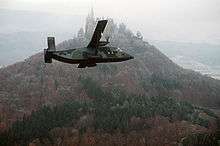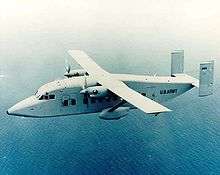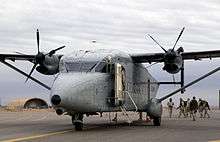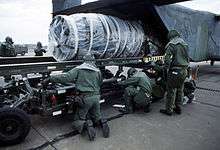Short C-23 Sherpa
| C-23 Sherpa | |
|---|---|
| | |
| A USAF C-23A Sherpa over then West Germany in 1985 | |
| Role | Transport aircraft |
| National origin | United Kingdom |
| Manufacturer | Short Brothers |
| First flight | 6 August 1984 |
| Introduction | 1984 |
| Retired | Army National Guard 2014 |
| Status | In service |
| Primary users | United States Army United States Air Force |
| Produced | 1984-1990 |
| Developed from | Short 330, Short 360 |
The Short C-23 Sherpa is a small military transport aircraft built by Short Brothers. The C-23A and C-23B are variants of the Short 330 and the C-23B+ is a variant of the Short 360.
Design and development
The Short 330 was developed by Short Brothers of Belfast from their earlier Short Skyvan STOL utility transport. The 330 had a longer wingspan and fuselage than the Skyvan, while retaining the Skyvan's square shaped fuselage cross section, allowing it to carry up to 30 passengers while retaining good short field characteristics.[1] The 330 entered commercial service in 1976.

In addition to the passenger aircraft, Shorts also planned two freight versions. The Short 330-UTT (for Utility Tactical Transport) was a military transport version fitted with a strengthened cabin floor and paratroop doors,[2] which was sold in small numbers, primarily to Thailand, which purchased four. The Short Sherpa (not to be confused with the earlier Short SB.4 Sherpa experimental aircraft) was a freighter fitted with a full-width rear cargo door/ramp. This version first flew on 23 December 1982,[2] with the first order for 18 aircraft being placed by the United States Air Force in March 1983. These aircraft were assigned to Military Airlift Command (MAC) for the European Distribution System Aircraft (EDSA) role, flying cargo and personnel between US Air Forces in Europe (USAFE) air bases.[2]
In U.S. military service, the Short 330 was designated C-23A Sherpa. The C-23B Sherpa was similar to the C-23A, but with cabin windows.[3] The C-23B+ Short 360 derivative was created by replacing the rear fuselage of Short 360s obtained on the second-hand market with the twin tail and rear loading ramp of the Short Sherpa.
The C-23 was produced at the Short Brothers' facility in Belfast, Northern Ireland for the U.S. Dept. of Defense.[4]
Operational history


U.S. Air Force
The C-23A Sherpa entered service with the United States Air Force in Europe in 1985[4] based at Zweibrücken Air Base. It continued in use in the EDSA role until November 1990 with the post-cold war force reductions.[5] All the Sherpas were returned to the United States; three aircraft were given to the USAF Test Pilot School at Edwards AFB, eight aircraft were given to the U.S. Army and the remaining seven to the United States Forest Service. The Test Pilot School aircraft were retired in 1997.[5]
U.S. Army
The eight former USAF aircraft were used for test duties at different units; two were re-designated as JC-23A.[5]
The Army purchased four civil Short 330 aircraft to replace the DHC C-7 Caribou being used to support the Kwajalein Missile Range. These were not given a C-23 designation, and were retired in 1992.[5] In 1988, the Army ordered ten new-build Short 330s designated C-23B to replace the DHC C-7 Caribou used by the U.S. Army National Guard Aviation and Repair Activity Depots. In 1990, a further six were ordered.[5]
When the Army wanted 20 more C-23s in 1990 the production line had closed; second-hand Short 360 aircraft were purchased instead. Designated the C-23B+, these were modified from the original single tail to the twin-tail and cargo ramp of the other C-23Bs.[5] In 1994, another eight aircraft were converted to replace the DHC UV-18 Twin Otters used in Alaska.[5]
During Iraq War (2003–2011), the C-23 served the Army's intra-theater needs of cargo and personnel transport. It provided an economic alternative for transporting some 20 people or three pallets of cargo when speed was not critical.[6]
As part of the U.S. Army's Constant Hawk intelligence gathering program, five Short 360s were modified for use in Iraq and flew in theater between 2006 and 2011. A further two modified aircraft collided in mid-air before delivery to Iraq. The Constant Hawk aircraft were not given a military designation.[5]
On 13 June 2007, the Alenia C-27J was selected to replace the C-23 in U.S. Army service.[7][8] A total of 43 C-23s were in service with the U.S. Army as of November 2008.[9] The C-23 Sherpa was retired from the Army National Guard in January 2014.[10] As part of the National Defense Authorization Act for Fiscal Year 2014, 8 C-23s may be transferred to the State of Alaska to operate from short rural runways for search-and-rescue and medium-lift missions.[11]
In December 2014, it was announced that US would supply eight aircraft to Estonia, Djibouti, and Philippines.[12][13]
Civilian and Air National Guard service
Several surplus aircraft were sold to US operators,[14] who used them to transport equipment and crews to remote work sites. Others were used by Air National Guard units in the various US states.
On 3 March 2001, a C-23B Sherpa belonging to the 171st Aviation Regiment of the Florida Army National Guard was carrying 18 construction workers from Hurlburt Field (Florida) to Naval Air Station Oceana (Virginia). The pilot left the flight deck to use the aft bathroom. His weight in the tailcone shifted the center of gravity sufficiently (later calculations determined that the aircraft had been loaded outside its operating envelope at the start of the flight) that the airplane became unstable when a patch of severe turbulence was encountered. The violent g-force shifts then encountered rendered the crew unconscious and caused the breakup of the aircraft in flight near Unadilla, Georgia, killing the 21 persons on board.[15]
Variants
- C-23A Sherpa
- Twin-engine transport aircraft for the U.S. Air Force based on the Short 330-UTT; it was fitted with a strengthened cabin floor with a roller conveyor system, plus a forward cargo door on the port side of the fuselage, equipped with a hydraulically operated full-width rear cargo door/ramp; 18 built.
- C-23B Sherpa
- Twin-engine transport aircraft for the US Army National Guard, similar to the C-23A, but with cabin windows, stronger landing-gear, inward-opening paratroop doors at the rear of the fuselage and an air-operable two-section cargo ramp; 16 built.[5]
- C-23B+ Super Sherpa
- Short 360 aircraft purchased as used aircraft by the U.S. Army and modified by the West Virginia Air Center (WVAC) for the replacement of the rear fuselage of the Short 360, with its single tall fin, with the twin tail and rear loading ramp of the Short Sherpa.[16] 28 civil aircraft were modified.[5]
- C-23C
- Both C-23B and C-23B+ with flightdeck avionic upgrade under the "Avionics System Cockpit Upgrade" program, 43 modified.[5]
- C-23D
- C-23C with upgraded avionics under the "Safety Avionics Modification" program from 2010, program was cancelled and only four aircraft were modified.[5]
Operators

Civil operators
Former USAF and US Army aircraft have been sold to civil operators including:
- Royal Star Aviation[5]
- Era Aviation[5]
- Freedom Air[5]
- Richland County Sheriffs Department (South Carolina)[5]
Aircraft on display
- United States
- Short 330-200 85-25343, a former Kwajalein range aircraft, at Millville Army Aviation Museum, Millville, New Jersey.[5]
- C-23C - N863DZ, which was US Army 93-01320, at Air Heritage Museum, Beaver County Airport, Pennsylvania.[5]
Specifications
C-23A
Data from Jane's All the World's Aircraft, 1988-1989[2]
General characteristics
- Crew: Three (Two pilots plus one cabin crew)
- Capacity: 30 passengers, or 18 Litter based passengers
- Length: 58 ft 0 in (17.69 m)
- Wingspan: 74 ft 9 in (22.78 m)
- Height: 16 ft 3 in (4.95 m)
- Wing area: 453 ft² (42.1 m²)
- Airfoil: NACA 63 series, modified
- Empty weight: 14,200 lb (6,440 kg)
- Max. takeoff weight: 22,900 lb (10,387 kg)
- Powerplant: 2 × Pratt & Whitney Canada PT6A-45-R turboprops, 1,198 hp (894 kW) each
Performance
- Maximum speed: 281 mph (245 knots, 453 km/h) at 12,000 ft (3,657 m)
- Cruise speed: 255 mph (221 knots, 410 km/h)
- Stall speed: 85 mph (73 knots, 136 km/h) with flaps and landing gear down
- Range: 770 mi (670 nm, 1,239 km) passenger version, 1,966 kg payload with no reserves
- Service ceiling: 27,000 ft (5,114 m)
- Rate of climb: 2,100 ft/min (10.6 m/s)
- Wing loading: 50.6 lb/ft² (247 kg/m²)
- Power/mass: 0.052 hp/lb (170 W/kg)
C-23B/C

Data from U.S. Army Aircraft Since 1947[17]
General characteristics
- Crew: Three (Two pilots plus flight engineer)
- Capacity: 18-20 passengers
- Length: 58 ft 0 in (17.7 m)
- Wingspan: 74 ft 10 in (22.8 m)
- Height: 16 ft 5 in (5.0 m)
- Wing area: 456 ft² (42.4 m²)
- Airfoil: NACA 63 series, modified
- Empty weight: 16,040 lb (7,276 kg)
- Max. takeoff weight: 25,600 lb (11,610 kg)
- Powerplant: 2 × Pratt & Whitney Canada PT6A-65AR turboprop, 1,424 shp (1,062 kW) each
Performance
- Maximum speed: 291 mph (252 knots, 468 km/h)
- Cruise speed: 262 mph (228 knots, 422 km/h)
- Range: 1,185 mi (1,030 nmi, 1,907 km)
- Service ceiling: 28,000 ft (5,303 m)
See also
- Related development
- Aircraft of comparable role, configuration and era
References
- ↑ Donald, David (Editor) (1997). The Encyclopedia of World Aircraft. Aerospace Publishing. ISBN 1-85605-375-X.
- 1 2 3 4 Taylor, JWR (Editor) (1988). Jane's All the World's Aircraft, 1988-1989. Jane's Information Group. ISBN 0-7106-0867-5.
- ↑ Donald, David; Lake, John, eds. (1996). Encyclopedia of World Military Aircraft (Single Volume ed.). London: Aerospace Publishing. p. 384. ISBN 1-874023-95-6.
- 1 2 "C-23 Sherpa".
- 1 2 3 4 5 6 7 8 9 10 11 12 13 14 15 16 17 18 "Whatever happened to .. C-23 Sherpa". Scramble Magazine. No. 427. Dutch Aviation Society. December 2014. pp. 150–157. ISSN 0927-3417.
- ↑ "C-23: A Small Cargo Plane that Makes a Big Difference", Military.com, February 9, 2004.
- ↑ "C-27J Spartan named as Joint Cargo Aircraft". Air Force Link. 14 June 2007. Archived from the original on 26 May 2012. Retrieved 17 June 2007.
- ↑ "C-27J tapped for Joint Cargo Aircraft". Air Force Times. 14 June 2007. Retrieved 17 June 2007.
- ↑ "Directory: World Air Forces", Flight International, 11–17 November 2008.
- ↑ C-23 Sherpa makes final flight as Army Guard retires the venerable aircraft - Dvidshub.net, 10 January 2014
- ↑ The Final Army Flight of the C-23 Sherpa - Defensemedianetwork.com, 27 January 2014
- ↑
- ↑ "USA kingib Eestile kaks transpordilennukit - Eesti uudised - Postimees.ee".
- ↑ Used Aircraft - Shorts
- ↑ Business & Commercial Aviation (26 May 2016)
- ↑ Pike, John. "C-23 Sherpa".
- ↑ Harding, Stephen (1997). U.S. Army Aircraft Since 1947. Atglen, Pennsylvania USA: Schiffer Publishing Ltd. pp. 224–226. LCCN 96-69996.
External links
| Wikimedia Commons has media related to C-23 Sherpa. |
- C-23 Sherpa page on Florida National Guard site
- C-23 page on Global Security.org
- C-23 page on theAviationZone.com
- 10th MAS C-23A Sherpa Zweibrücken AFB reunion site